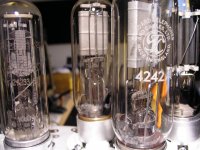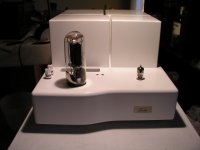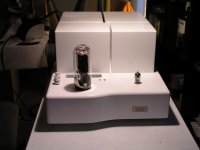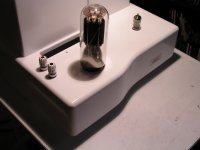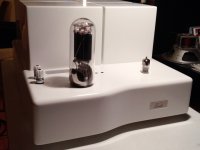Today I finished listening to various 211 tubes.
It was such a pleasure to play with vintage 211 tubes that have now become quite rare to find in New condition. Fortunately, all these pieces were new and all measure around the same transconductance.
The 211 tubes were the following:
Of all the above-mentioned tubes, one was playing music quite differently. It was not simply better, it was different! Its sound reminded me of the sublime 210 tubes with mesh anode (type 10 or VT-25 variant), it had that sparkle, light and energy and that amazing portrayal of depth that are enough to drive you to heaven like no other high power tube I have ever experienced. And they have been quite a lot of them...
Can you guess anything?
It was such a pleasure to play with vintage 211 tubes that have now become quite rare to find in New condition. Fortunately, all these pieces were new and all measure around the same transconductance.
The 211 tubes were the following:
- Western Electric 242c
- STC 4242
- RCA 211
- General Electric VT-4C
- Telefunken RS237
Of all the above-mentioned tubes, one was playing music quite differently. It was not simply better, it was different! Its sound reminded me of the sublime 210 tubes with mesh anode (type 10 or VT-25 variant), it had that sparkle, light and energy and that amazing portrayal of depth that are enough to drive you to heaven like no other high power tube I have ever experienced. And they have been quite a lot of them...
Can you guess anything?
Attachments
Many years ago I carried out the same exercise with exactly the same tubes! I too found that one was far far more pleasant to the ear than the others...but it lacked the immediate impact of the others...especially in the bass. (the pair of Telefunken were marked as the property of the Luftwaffe - and was the second favourite of the test tubes). The amplifier was a Be Yamamura creation which was on long time loan; it used the best of stock and special order Tamura transformers.
They were exceptionally expensive - due to the Tx compliment.
The favourite tube was the WE military version. 🙂
They were exceptionally expensive - due to the Tx compliment.
The favourite tube was the WE military version. 🙂
Was someone else switching the tubes and keeping notes without telling you which one you were listening to?
If so, did you repeat the test the next day to see if you came to similar conclusions?
If so, did you repeat the test the next day to see if you came to similar conclusions?
Not all are 211 exact types. The socket pins and the power rating may be the same but some tubes 242 variants uses different filament / cathode materials. One can expect a different sound from these tubes.
But what tubes come out top in your roundup? I suspect your amp using a lot of magnetic materials will make it more apparent due to some phase shift introduced by the many Interstage Tx stages.
But what tubes come out top in your roundup? I suspect your amp using a lot of magnetic materials will make it more apparent due to some phase shift introduced by the many Interstage Tx stages.
Hello guys. Sorry for my absence!
The best 211 variant was RS237 manufactured by Telefunken. Miles ahead of the competition.
Light, energy, sparkle, finesse... It has a different way to play music. Everything lights up! Tons of involvement & emotion!
The white knobs are classic WBT NextGen, white colored.
Regarding megasat16 statement, I cannot see any reason for phase anomalies introduces by the *single* interstage transformer. The first stage measures dead flat up to 90kHz under the worse conditions.
The best 211 variant was RS237 manufactured by Telefunken. Miles ahead of the competition.
Light, energy, sparkle, finesse... It has a different way to play music. Everything lights up! Tons of involvement & emotion!
The white knobs are classic WBT NextGen, white colored.
Regarding megasat16 statement, I cannot see any reason for phase anomalies introduces by the *single* interstage transformer. The first stage measures dead flat up to 90kHz under the worse conditions.
Well, Single or NOT, the IT usually have a leading phase at low frequency and a lagging phase at a high frequencies above 10KHz. Reasonably good IT have about 3-8 degrees between 20-100Hz and less than 2-4 degrees lagging above 10KHz-20KHz. My observations measuring many different kinds of IT.
Phasing is not necessarily a bad thing at all! 🙂
Phasing is not necessarily a bad thing at all! 🙂
I do not know how keen are you in electronics...
Phase anomalies are caused due to the inability of the transformer to provide load linearity in the frequency domain. In other words, it is caused of limitations that nature provide and /or limitations of the design. It always goes side by side with frequency anomalies, but first of all come phase anomalies. Then you experience all the rest...
Not all ISTs are equal. If course phase anomalies may exist at eg 5-10Hz and at 100kHz. Phase anomalies are *always* a bad thing and need to be avoided. However, the designer is responsible for how high he wants to place the target.
Take care!
Pavgeris
Phase anomalies are caused due to the inability of the transformer to provide load linearity in the frequency domain. In other words, it is caused of limitations that nature provide and /or limitations of the design. It always goes side by side with frequency anomalies, but first of all come phase anomalies. Then you experience all the rest...
Not all ISTs are equal. If course phase anomalies may exist at eg 5-10Hz and at 100kHz. Phase anomalies are *always* a bad thing and need to be avoided. However, the designer is responsible for how high he wants to place the target.
Take care!
Pavgeris
Well, I am pretty serious about measuring and comparing IT to invest in several hundreds of them alone. I would love to measure your so called perfect IT. How do I obtain it?
So far, I have not seen any IT that does not exhibit leading and lagging phase amid very flat FR within 1dB from 20-20KHz. My measurment includes UTC / Tango / Chicago / Stancor / Lundahl Transformers.
Like I said, minor phase issues are not to be dreaded. It's what has been done throughout the commercial broadcast equipment for decades before. It's been done at the limiter at the recording industry for decades. Ribbon Mic going through the input step up transformers will have phase shift as long as input step up transformer is used.
So far, I have not seen any IT that does not exhibit leading and lagging phase amid very flat FR within 1dB from 20-20KHz. My measurment includes UTC / Tango / Chicago / Stancor / Lundahl Transformers.
Like I said, minor phase issues are not to be dreaded. It's what has been done throughout the commercial broadcast equipment for decades before. It's been done at the limiter at the recording industry for decades. Ribbon Mic going through the input step up transformers will have phase shift as long as input step up transformer is used.
Last edited:

Nice amp congratulations.
What is the input tube?
What is the brand of the dual knobs at left?
D3a or EC8010?
That is my guess 😀
- Status
- Not open for further replies.
- Home
- Member Areas
- The Lounge
- 211 tubes rolling

